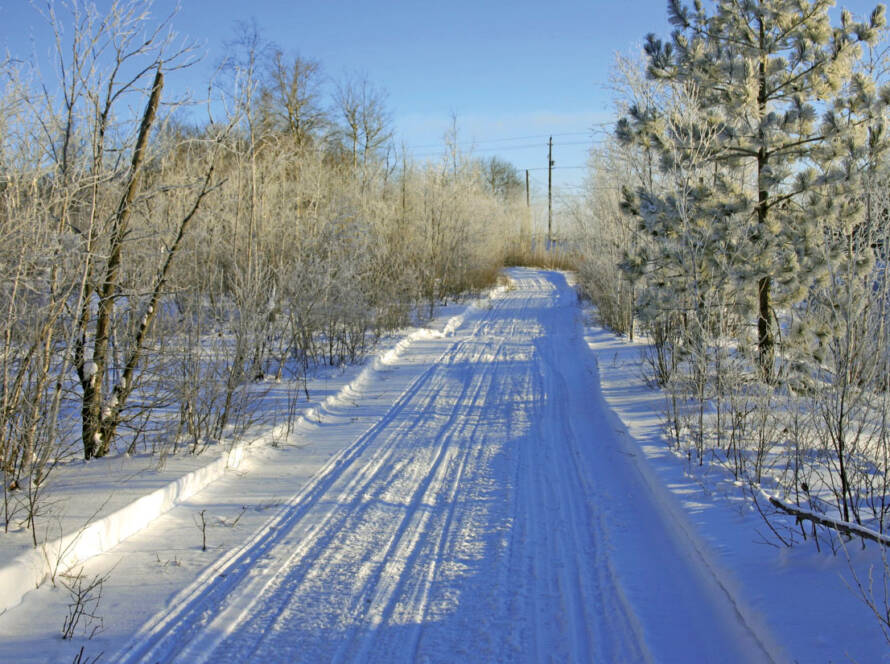If there’s something the Washburn Trail Runners Snowmobile Club is really well-known for, it’s their hospitality. It’s seen in the popular home-cooked meals the club based in Washburn, Maine, offers to snowmobiling enthusiasts who stop by the clubhouse on winter weekends. However, as Tim Stitham will tell you, it goes well beyond that.
“It’s a community of snowmobilers here,” said Stitham, president of the Washburn Trail Runners. “If there’s somebody in need, it doesn’t matter what we’re doing. We will drop whatever that is and help out.
“I could probably ramble off half a dozen different scenarios where I’ve been at home peacefully relaxing, watching TV and I’ll get a phone call saying, ‘Hey, I have a report of a guy who has a broken-down sled and they’re walking towards a road crossing. It’s 10 degrees outside and it’s pitch black out there. Any chance you guys can help them out?’”
More evidence of this commitment to snowmobiler safety can be seen in a custom-built device that the club plans to use this season.
The device, essentially a large trailer on skis that can be towed behind a snowmobile, will be used not only to mark trails, but also to help snowmobilers in trouble.
“If there’s a report of an injured person that’s been in a snowmobile accident on the trails, the local fire department can use it to perform rescue operations on the trail,” said Stitham. “We really take pride in doing the very best we can for the snowmobilers, whether they’re a member or not, quite frankly.”
Prime real estate for snowmobiling
The Washburn Trail Runners Snowmobile Club was founded in 1989 by a group of 20 or so snowmobile enthusiasts from Washburn and the nearby communities of Wade and Perham.
“They got together and decided that there was a need for an organization to maintain the trails and to provide a service for people who snowmobile in the area,” Stitham said, pointing out that Aroostook County, where Washburn is located, is an exceptionally popular destination for snowmobilers.
Stitham says more than half of the Washburn Trail Runners’ 270-plus members are from outside the community and come from as far away as New Hampshire, Vermont, Massachusetts, Pennsylvania, and even North Carolina to ride the area’s trails, which are part of a larger interstate snowmobiling network.
“We are on two major trail systems that go north, south, east and west from here,” said Stitham, noting that the Washburn Trail Runners are responsible for maintaining about 42 miles of the trail system. “We are really in a prime location when it comes to snowmobiling.
“The clubhouse itself is located just feet from the trail. We’re at a T intersection, and all snowmobiles that go by here have to stop. On a busy weekend, you could have more than 1,000 snowmobiles go through that intersection.”
Stitham said the Washburn Trail Runners’ trails are situated in “really good snowmobiling country. Much of our trail system utilizes abandoned railway lines and passes through agriculture land in an area that’s well-known for growing potatoes.”
Part of the system is also located in a heavily forested region known as the Northern Maine Woods, where, as Stitham said, “You’re riding right through the middle of the wilderness.”
It’s in this section of the trail system that something quite unusual can be found – a place deep in the woods where in September 1942, a B-25C Mitchell bomber plane went down.
“Back in the 1940s, there used to be a U.S. Air Force base in Presque Isle, Maine. There were eight B-25 bombers that had left to head over to assist in the war effort. They were called back to base due to poor weather conditions, six made it back, one made it to the next stop and this one crashed in the remote wooded area between Perham and Portage. There were no survivors,” said Stitham.
“The plane lost its tail section nearly a quarter-mile before the crash site, leaving speculation that the plane was sabotaged. Later that same day, another B-25 took off from Presque Isle and crashed in Fort Fairfield, Maine. Investigations resulted in two Nazi sympathizers being arrested.
“The townsfolk that were here back in that day said they actually had to cut a road in to where the plane had crashed because it was so remote. And part of that road is what we now use as a snowmobile trail.”
Stitham says quite a bit of wreckage remains at the site.
“The fuselage was taken away, but the wings were left. There are engines and the landing gear out there,” he said.
“And you can still see to this day where the plane came down. The impact and the fuel that it was carrying burned and scorched the land so badly that the trees have really struggled to regrow.”
Committed volunteers
The Washburn Trail Runners’ clubhouse is situated right in Washburn itself. It’s an old fertilizer storage facility that’s been renovated and it features a restaurant-quality kitchen that offers breakfasts and lunches to passing snowmobilers or anyone else looking for a tasty home-cooked meal.
“There have been days where there’s been 100 people here sitting down and a line of 40 out the door waiting to come in,” said Stitham, adding the weekend meals are offered from the first weekend in January to the last weekend in March.
“We’re not out in the middle of nowhere. We are right in town,” Stitham said. “It is a great spot for the community to come here on the weekends and gather, have a nice meal, sit at the table, talk with people that they may not have talked with all year long.”
Stitham says the weekend meal program, which has become an important fundraiser for the club, wouldn’t be possible without the commitment from dedicated volunteers such as Dick and Audrey Hartford, who have been running the kitchen for close to a decade.
“Everything we do here is volunteer. Nobody makes a penny on what we do, from kitchen staff to the people who wait tables and whatever,” he said. It’s all members volunteering their time to, if you will, pay it forward to the snowmobiling patrons that come in here.”
Every winter, about 12 to 15 Washburn Trail Runners’ members volunteer their time to groom the club’s trails, which is done using a 2005 Cat Challenger MT745B tracked tractor and Trail Paver II drag.
According to Stitham, the grooming volunteers represent “a really good mix of beginner, intermediate and experienced operators.”
Stitham says beginners don’t go out on the trails alone at first and are always accompanied by other, more experienced operators who can show them the ropes.
“It’s a two-year process with the new guys. Once they get that experience, then they move into that intermediate stage and then it’s up to them to show the next group that’s coming in how to do this as well,” Stitham said.
“When I’m out with somebody who doesn’t have a lot of experience, I’m trying to teach them about the things to not do, like don’t get too close to the edge of the trail or don’t take your eyes off of where your tracks are at all times.
“Once we get them so they’re not doing those things, then we really focus on understanding how the drag itself operates and the finer skills needed to make a really good trail.”
Stitham says the area gets a good supply of snow – usually around 10 to 12 feet each season – and the snowmobiling season typically lasts from sometime in December to mid-April, depending on how quickly it warms up in the spring.
“We groom every single night during the winter season. This wouldn’t be possible without the dedication of our trail master and all the groomer operators,” he said.
“A team of two operators will typically leave here around 7 o’clock. If everything goes right and the grooming is good, you’ll typically be back here by 1 o’clock in the morning. Sometimes, though, if you’re going out after a large snowstorm, you could be getting back in when the sun is just coming back up. I’ve done that myself on quite a few occasions.”
Stitham says the club’s trail master is his good friend Kevin Goodine – a job Goodine takes very seriously and does very well.
“[Goodine] works well with all the other operators and he’s really passionate about making sure that the trails are in excellent condition. He comes down here on his days off to check on the machine to make sure the equipment is where it needs to be, so that nobody gets stuck out in the middle of the night with a broken machine,” said Stitham.
“He understands that the position of trail master goes far beyond the maintaining of the trails. His attention to detail has made our trails some of the safest and nicest in the area.”


![[image placeholder]](https://www.snowopsmag.com/wp-content/uploads/2023/09/placeholder@2x-890x664.png)
